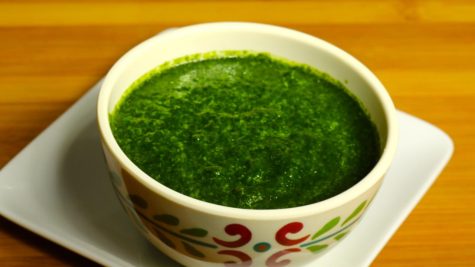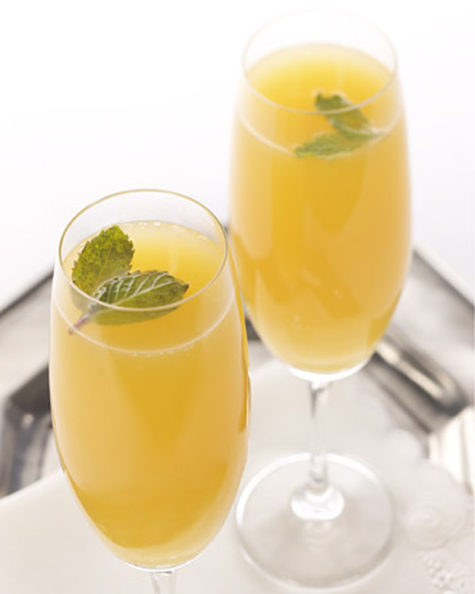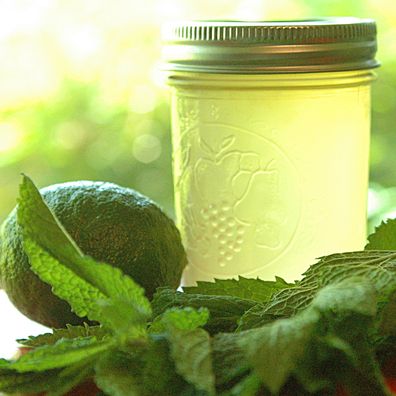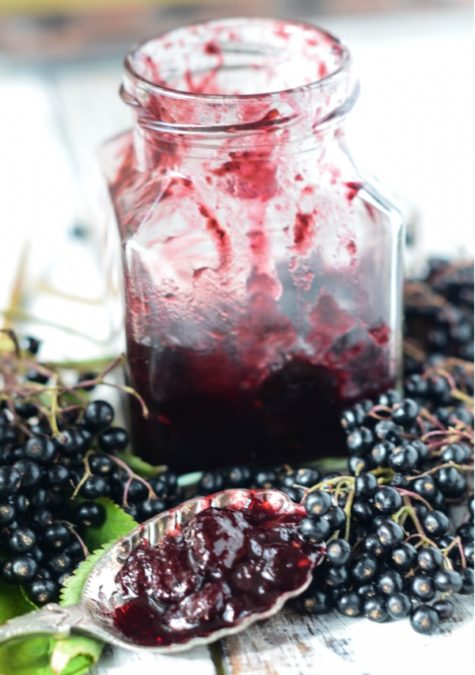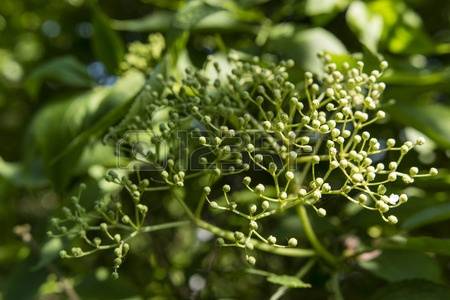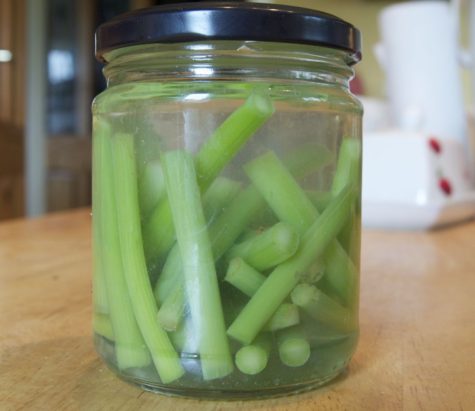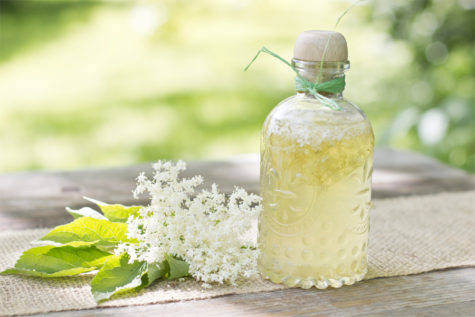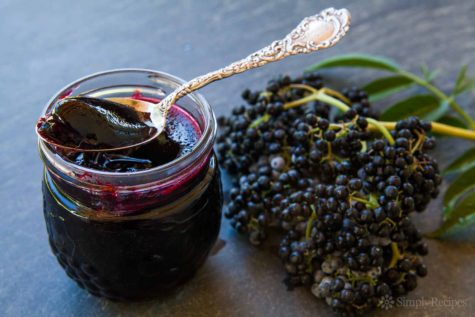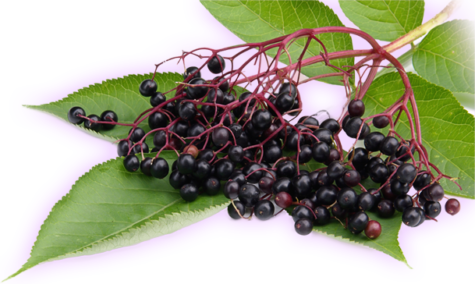Yearly Archives: 2017
Mint Chutney
Mint chutney is a delicious condiment, blend of mint and cilantro combined with spices. Most Indian snacks are incomplete without chutney. Chutney also tastes great with a main meal. Try using mint chutney as a spread for your sandwiches – it tastes great!
Recipe will serve 6.
Preparation time 15 minutes
Cooking time 10 minutes
Ingredients:
- 1 cup packed mint (podina) leaves all the stems removed
- 1 cup packed Cilantro (hara dhania) roughly chopped
- 2 tablespoons green chilies chopped (adjust to taste)
- 2 tablespoons lemon juice (adjust to taste)
- 1/2 inch ginger chopped
- 1 teaspoons salt (adjust to taste)
- 2 tablespoons sugar
- Pinch of asafetida (hing)
- Approx. 3 tablespoons water use as needed
Instructions:
Blend all ingredients, except the mint and cilantro, into a paste. Add mint and cilantro, a little at a time, and blend until smooth. Add water as needed. Taste and adjust salt, green chilies, or lemon juice as desired. Tastes great with samosa, vegetable pakoras….
Suggestions:
You can make mint chutney in large quantity in advance and freeze it in ice cube trays. Store the frozen cubes in a zip-lock plastic bag. When ready to serve, defrost as many cubes of mint chutney as needed.
Note:
The most common mint used in Indian cooking is Podina or Peppermint. However, any variety of mint can be used. Just be aware that the flavor will not be quite the same.
From: Manjulas Kitchen
Mimosas with Fresh Mint and Oranges
This is a very cooling summer drink.
Ingredients:
- 1 orange
- 2 cups fresh orange juice
- 1 cup sparkling wine or champagne
- 1 to 3 drops peppermint essential oil (to taste)
- 4 fresh mint leaves, for garnish
Slice orange in half. Cut two thin slices of the orange & save them to use as a garnish. Stir orange juice together with the sparkling water, add the peppermint oil.. Serve in champagne flutes & garnish each glass with two mint leaves & one thin orange slice.
Note: Sparkling mineral water or ginger ale can be substituted for the wine.
Fresh Peppermint Jam
Fresh Peppermint Jam:
- 250 g of peppermint leaves
- 1 kg of sugar
- 2 lemons
- 0.5 liters of water
Wash mint leaves with stems, dry slightly and chop. Cut lemons into small pieces with the skin. Put everything into the pot and boil for 10 minutes. Leave for a day. Filter the infusion, add the sugar and cook until tender. Pour hot boiled jam into jars and close tight.
From: Herbal Picnic
Elderberry Chutney
Here we have 2 very old recipes for Chutney made with Elderberries:
- 2 lb. Elderberries,
- 1 large Onion,
- 1 pint Vinegar,
- 1 teaspoonful Salt,
- 1 teaspoonful ground Ginger,
- 2 tablespoonful Sugar,
- 1 salt spoonful Cayenne and mixed spices,
- 1 teaspoonful Mustard seed.
Stalk, weigh and wash the berries; put them into a pan and bruise with a wooden spoon; chop the onion and add with the rest of the ingredients and vinegar. Bring to the boil and simmer till it becomes thick. Stir well, being careful not to let it burn as it thickens. Put into jars and cover.
Second Recipe:
- 1 1/2 lb. of Elderberries
- 1 Onion
- 6 Cloves
- 1/4 oz. ground Ginger
- 2 oz. Demerara Sugar
- 3 oz. Raisins
- a dust of Cayenne and Mace
- 1 teaspoonful Salt
- 1 pint Vinegar.
Rub the berries through a wire sieve. Then pound the onion with the spices, raisins and salt. Add the vinegar and put all in an enameled saucepan and boil with the pulp of the berries for 10 minutes. Take the pan from the fire and let it stand till cold. Put the chutney into jars and cork securely.
From: A Modern Herbal
Note: Most species of Elderberry are edible when picked ripe and then cooked. Both the skin and pulp can be eaten. However, it is important to note that most uncooked berries and other parts of plants from this genus are poisonous. European Elderberry (Sambucus nigra) is the variety that is most often used for health benefits as it is the only variety considered to be non-toxic even when not cooked.
Pickled Elder Blooms and Shoots
One seldom has the chance of now tasting the old country pickle made from the tender young shoots and flowers of the European Elder. John Evelyn, writing in 1664, recommends Elder flowers infused in vinegar as an ingredient of a salad. The pickled blossoms are said by those who have tried them to be a welcome relish with boiled mutton, as a substitute for capers.
Clusters of the flowers are gathered in their unripened green state, put into a stone jar and covered with boiling vinegar. Spices are unnecessary. The jar is tied down directly the pickle is cold. This pickle is very good and has the advantage of costing next to nothing.
The pickle made from the tender young shoots – sometimes known as ‘English Bamboo’ – is more elaborate. During May, in the middle of the Elder bushes in the hedges, large young green shoots may be observed. Cut these, selecting the greenest, peel off every vestige of the outer skin and lay them in salt and water overnight.
Each individual length must be carefully chosen, for while they must not be too immature, if the shoots are at all woody, they will not be worth eating, The following morning, prepare the pickle for the Mock Bamboo.
To a quart of vinegar, add an ounce of white pepper, an ounce of ginger, half a saltspoonful of mace and boil all well together. Remove the Elder shoots from the salt and water, dry in a cloth and slice up into suitable pieces, laying them in a stone jar. Pour the boiling mixture over them and either place them in an oven for 2 hours, or in a pan of boiling water on the stove. When cold, the pickle should be green in colour. If not, strain the liquor, boil it up again, pour over the shoots and repeat the process.
The great art of obtaining and retaining the essence of the plant lies in excluding air from the tied-down jar as much as possible.
Elderflower Vinegar
Here is a very old recipe for Elderflower Vinegar:
Take 2 lb. of dried flowers of the European Elder. If you use your own flowers, pluck carefully their stalks from them and dry them carefully and thoroughly. This done, place in a large vessel and pour over them 2 pints of good vinegar. Close the vessel hermetically, keep it in a very warm place and shake them from time to time. After 8 days, strain the vinegar through a paper filter. Keep in well-stoppered bottles.
This is an old-world simple, but rarely met with nowadays, but worth the slight trouble of making. It was well-known and appreciated in former days and often mentioned in old books; Steele, in The Tatler, says: ‘They had dissented about the preference of Elder to Wine vinegar.’
From: A Modern Herbal
Elderberry Jams and Jelly
Most species of Elderbery are edible when picked ripe and then cooked. Both the skin and pulp can be eaten. However, it is important to note that most uncooked berries and other parts of plants from this genus are poisonous. Sambucus nigra the European Elderberry is the variety that is most often used for health benefits as it is the only variety considered to be non-toxic even when not cooked.
The Fruit Preserving Section of the Food Ministry issued during the War the following recipe for Elderberry and Apple Jam:
- 6 lb. Elderberries,
- 6 lb. sliced apples,
- 12 lb. sugar.
Make a pulp of the apples by boiling in water till soft and passing through a coarse sieve to remove any seeds or cores. The Elderberries should also be stewed for half an hour to soften them. Combine the Apple pulp, berries and sugar and return to the fire to boil till thick.
Another Recipe:
Equal quantities of Elderberries and Apples, 3/4 lb. sugar and one lemon to each pound of fruit. Strip the berries from the stalks, peel, core and cut up the apples and weigh both fruits. Put the Elderberries into a pan over low heat and bruise them with a wooden spoon. When the juice begins to flow, add the Apples and one-third of the sugar and bring slowly to the boil. When quite soft, rub all through a hair sieve. Return the pulp to the pan, add the rest of the sugar, the grated lemon rind and juice and boil for half an hour, or until the jam sets when tested. Remove all scum, put into pots and cover.
Elderberry Jam without Apples:
To every pound of berries add 1/4 pint of water, the juice of 2 lemons and 1 lb. of sugar. Boil from 30 to 45 minutes, until it sets when tested. Put into jars and tie down when cold.
Elderberry Jelly:
The Elderberry will, of course, also make a jelly. As it is a juicy fruit, it will not need the addition of any more liquid than, perhaps, a squeeze of lemon. Equal quantities of Elderberry juice and apple juice, and apple juice from peeling, will require 3/4 lb. of sugar to a pint. Elderberry Jelly is firm and flavorous, with a racy tang.
Source: A Modern Herbal
Elderberry Ketchup
Here is a very old recipe for Elderberry Ketchup. When making this recipe, be sure that you are using the berries from the European Elder, Sambucus nigra, as berries from other varieties may cause nausea and vomiting.
Elderberry Ketchup
- 1 pint Elderberries,
- 1 oz Shallots
- 1 blade Mace
- 1/2 oz Peppercorns
- 1 1/2 oz whole Ginger
- 1 pint Vinegar
Pick the berries (which must be ripe) from the stalks, weigh and wash them. Put them into an unglazed crock or jar, pour over the boiling vinegar and leave all night in a cool oven. Next day, strain the liquor from the berries through a cloth tied on to the legs of an inverted chair and put it into a pan, with the peeled and minced shallots, the ginger peeled and cut up small, the mace and peppercorns. Boil for 10 minutes, then put into bottles, dividing the spices among the bottles. Cork well.
From: A Modern Herbal
Green Elder Shoots
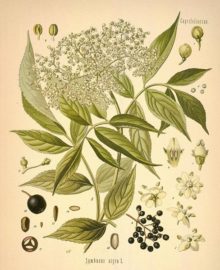 In spring and early summer the European Elder, Sambucus nigra, produces very vigorous strong green shoots from the base of the plant and sometimes the green growths arise along older branches. These can be cut, peeled and after being soaked in salted water overnight they can be eaten raw or cooked. The most surprising thing is that they are very tasty.
In spring and early summer the European Elder, Sambucus nigra, produces very vigorous strong green shoots from the base of the plant and sometimes the green growths arise along older branches. These can be cut, peeled and after being soaked in salted water overnight they can be eaten raw or cooked. The most surprising thing is that they are very tasty.
Elder has a very long history of household use as a medicinal herb and is also much used by herbalists. The plant has been called “the medicine chest of country people.” Visit the Encyclopedia of Herbology for more info on this useful herb.
Collecting the shoots
Cut the vigorous green growths in late spring. They can be a meter long or more, Do not collect any woody portions of the stems. If you try them and like them, you may want to have a couple of shrubs of Sambucus nigra that you grow especially for the stems. European Elder is an ideal plant for hard pruning in late winter. By cutting the previous years growth to with in 10 cm of the base in February each year strong vigorous shoots will be produced. Not all of these should be harvested, leave some to grow and produce food for the following year’s growth, much like one would treat asparagus.
Preparing the shoots:
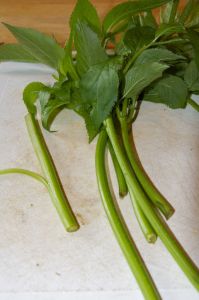 Remove the very soft tips and the leaves. Discard any portion of the stem that is becoming woody, either cut it or snap it away.
Remove the very soft tips and the leaves. Discard any portion of the stem that is becoming woody, either cut it or snap it away.
Use a sharp knife and remove all the skin from the stem. It peels away very easily. When you have peeled the shoots cut them into 15 cm lengths or whatever size suits.
The young shoots can now be boiled in salted water with a pinch of soda to preserve the colour, they prove beautifully tender, resembling spinach, and form quite a welcome addition to the dinner table.
To Brine the shoots:
Put the peeled shoots in a bowl, cover with water and add salt, a teaspoon in about 400 ml should be enough and then add a squeeze of lemon. I find that the lemon helps preserve the color.
Leave the stems over night. The following morning refresh the water, place the shoots in a sterilized jam jar with screw top lid. You can use less salt and add a squeeze of lemon juice to help preserve the shoots.
I am not sure how long the elder shoots will hold in this way, we are still experimenting! Now that you have the shoots, how do you eat them? Here’s a quick and tasty snack, easy to prepare.
Brined Elder shoots on toast with goat cheese:
- Slices of brown bread
- Clove of garlic
- Goat cheese (you can use cheddar or any cheese)
- Dried oregano
- Some green elder shoots in brine
Method:
Toast the bread in a toaster, meanwhile peel the garlic clove and slice or grate cheese, enough to cover your bread slices, heat up the grill too! When bread has popped from the toaster rub the peeled garlic on one side of the bread.
Place the cheese on the side rubbed with garlic, sprinkle with oregano and slice the elder shoots in half and place on top. Place bread under the grill and toast until the cheese has melted.
Collected from various sources including: Blooms and Food
